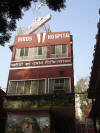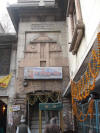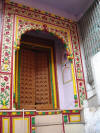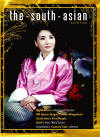Page 3 of 3
Chandni Chowk – South Asia’s oldest bazaar
(cntd.)
All photographs and text
copyright: The South Asian Media & Publishing
Landmarks
(Starting from the eastern end of the bazaar or the Red Fort
end and walking westwards towards Fatehpuri mosque)

The Digambar Jain Temple – The oldest Jain temple in
Delhi, it has had many additions to it since it was first built in 1526.
There are shrines of Lord Adinath, the first Tirthankar and also of Lord
Parasnath – the 23rd Tirthankar.
 The Bird Hospital – Built in 1928, by the Jain Temple
Trust, as a single room to provide first-aid for birds, this most unusual
hospital is now a four-storied haven for injured and sick birds. The bird
hospital is cleaner than most general hospitals for humans. There are three
types of facilities available at the hospital – birds can be brought in as
out-patients, they can be left as in-patients for intensive care, or
treatment can be advised over the phone. The in-patients go through a
process of classification. The very sick ones get their own individual
little cage, the moderately sick share a space with four or five other
like-minded birds, and the nearly-recovered ones are put in the General Ward
on the terrace – the most densely populated section of the hospital. The
over four thousand birds in the General Ward are remarkably quiet – one can
almost miss seeing them in the silence. All birds, once treated, fly away
into freedom. The Bird Hospital – Built in 1928, by the Jain Temple
Trust, as a single room to provide first-aid for birds, this most unusual
hospital is now a four-storied haven for injured and sick birds. The bird
hospital is cleaner than most general hospitals for humans. There are three
types of facilities available at the hospital – birds can be brought in as
out-patients, they can be left as in-patients for intensive care, or
treatment can be advised over the phone. The in-patients go through a
process of classification. The very sick ones get their own individual
little cage, the moderately sick share a space with four or five other
like-minded birds, and the nearly-recovered ones are put in the General Ward
on the terrace – the most densely populated section of the hospital. The
over four thousand birds in the General Ward are remarkably quiet – one can
almost miss seeing them in the silence. All birds, once treated, fly away
into freedom.
 Gauri Shankar Temple – Almost adjacent to the Jain
temple along Chandni Chowk is the Gauri Shankar temple – one of the most
important of Shiva temples in Delhi. The Lingam kept inside is 800 years
old. There are shrines to other Gods and Goddesses too in the temple
precinct. Gauri Shankar Temple – Almost adjacent to the Jain
temple along Chandni Chowk is the Gauri Shankar temple – one of the most
important of Shiva temples in Delhi. The Lingam kept inside is 800 years
old. There are shrines to other Gods and Goddesses too in the temple
precinct.
 SisGanj Guudwara SisGanj Guudwara – is built on the site where the tenth
Guru Tegh Bahadur was beheaded by Emperor Aurangzeb in 1675 for challenging
the royal orders to use force for conversions.
 Sunehri Masjid Sunehri Masjid (Golden mosque) – sits on a two metre
high platform adjacent to Sis Ganj Gurudwara. Named for its golden domes,
the mosque was built in 1721 during the reign of Muhammad Shah. It was from
the terrace of this mosque that the Persian king Nadir Shah watched his
troops massacre the citizens of Delhi in March 1737 – 270 years ago.
Thousands of people were killed and the streets and by-lanes of Delhi lay
littered with corpses for days.
 Naughara (Nine houses) and the Jain Swetambara Temple –
Ina cul-de-sac off Kinari bazaar is a row of nine houses with brightly
painted doors and potted plants at the entrance. These houses are over 100
years old. The Jain Swetambara Temple, with its marble façade, is at the end
of the cul-de-sac. Naughara (Nine houses) and the Jain Swetambara Temple –
Ina cul-de-sac off Kinari bazaar is a row of nine houses with brightly
painted doors and potted plants at the entrance. These houses are over 100
years old. The Jain Swetambara Temple, with its marble façade, is at the end
of the cul-de-sac.
State Bank of India Building – The imposing structure on
the right with Corinthian columns, arched doorways and creaky old lifts,
once housed the British Court. It was acquired by the Delhi Bank in 1847,
later by the Imperial Bank and subsequently by the State Bank of India.
 Lala Chunna Mal’s Haveli – just short of the Fatehpuri
mosque is a 126 room mansion replete with history. Built by Lala Chunna Mal
in 1848, the first Municipal Commissioner of Delhi. Chunna Mal was one of
the richest Delhite at the time, owning practically half the real estate in
Shahjahanabad. The Belgian chandeliers hanging in the main reception area
were once candle-lit. The candles have been replaced by electric bulbs.
Nandini and Anil Prashad, the eighth generation after Lala Chunna Mal still
live in the ancestral property – though not in all the rooms. They have 10
-12 rooms for their use, while the rest, belonging to different members of
the extended family, remain locked up. Anil and his wife Nandini live there
with their two Modern School educated sons, daughters-in-law and
grandchildren who do not wish to move to the openness of South Delhi. They
are all happy to be living in the wonder that is Chandni Chowk. Anil
explains this sentiment well when he says, "the feeling of living here is so
great, one can ignore the rest." Lala Chunna Mal’s Haveli – just short of the Fatehpuri
mosque is a 126 room mansion replete with history. Built by Lala Chunna Mal
in 1848, the first Municipal Commissioner of Delhi. Chunna Mal was one of
the richest Delhite at the time, owning practically half the real estate in
Shahjahanabad. The Belgian chandeliers hanging in the main reception area
were once candle-lit. The candles have been replaced by electric bulbs.
Nandini and Anil Prashad, the eighth generation after Lala Chunna Mal still
live in the ancestral property – though not in all the rooms. They have 10
-12 rooms for their use, while the rest, belonging to different members of
the extended family, remain locked up. Anil and his wife Nandini live there
with their two Modern School educated sons, daughters-in-law and
grandchildren who do not wish to move to the openness of South Delhi. They
are all happy to be living in the wonder that is Chandni Chowk. Anil
explains this sentiment well when he says, "the feeling of living here is so
great, one can ignore the rest."
Ghalib was a frequent visitor to the haveli and so were
other poets of the time. A plaque in the living room wall carries a Persian
verse – an ode to Delhi. The grandeur and regality of the family is captured
in the photograph of 1930s at the time of a wedding in the family. The huge
high-ceilinged hall could accommodate hundreds of guests – today a false
ceiling provides another level of floor.
The haveli, which is not open to public, has been declared a
Heritage building and yet has a public toilet, an electric transformer and a
pumping station right next to its entrance.

Fatehpuri Mosque – was built in 1650 by Fatehpuri Begum,
one of Emperor Shahjahan’s wives, at the western end of Chandni Chowk.
Dariba – the silver street. Shop after shop of silver
jewellery, artefacts, glasses and goblets, and flatware. Dariba is silver
craftsmen at their best. Beli Ram is among the oldest shops in Dariba –
dating back to 1897. Some of the dealers have opened outlets elsewhere in
South Delhi.
 Kinari Bazaar - A more colourful street there could not
possibly be. Each shop is a curiosity shop. ‘Kinari’ (gold braid stitched on
to a bridal dupatta or veil) Bazaar is a one-stop halt for all
embellishments required for a perfect Indian wedding. From invitation cards
and scrolls to ornate gold and silver braids, money garlands, lame turbans
and any imaginable wedding essential – it’s all here and happening! Kinari Bazaar - A more colourful street there could not
possibly be. Each shop is a curiosity shop. ‘Kinari’ (gold braid stitched on
to a bridal dupatta or veil) Bazaar is a one-stop halt for all
embellishments required for a perfect Indian wedding. From invitation cards
and scrolls to ornate gold and silver braids, money garlands, lame turbans
and any imaginable wedding essential – it’s all here and happening!
 Gadodia Market - the Spice Market of Khari Baoli Gadodia Market - the Spice Market of Khari Baoli –
Turning the right corner around Fatehpuri mosque is the world famous Khari
Baoli spice market. An unassuming arcade leads to a dark alley which opens
up suddenly revealing not only the colours but also the varieties and aroma
of each spice. The visit to the Spice Market is a learning experience. There
are over twelve varieties of turmeric, eight different types of gum,
infinite types of red chillies and spices that one has never seen or read of
– dry moss-like ‘chabbila’ or ‘charila’ for example, used a s a flavouring
to enhance meat dishes. All spices are displayed in gunny bags, carried in
and out of the market on long, narrow carts designed especially for the
narrow alleys, which keep getting narrower the deeper one goes into the
neighbourhood. Spice Market is a must on the Chandni Chowk agenda.
 Old Jalebi Wala – Over a 100 years old, this tiny corner
shop at the junction of Chandni Chowk and Dariba, used to open at five in
the morning to offer sizzling hot jalebis to the Delhi epicures. But times
they are changing. It now opens at 8.30 a.m and close at 10 p.m – how many
kilos of jalebis get consumed in those 14 hours – one doesn’t know – but
certainly a lot. The owner claims to have supplied his jalebis to the Nehru
and Shastri (erstwhile Prime Ministers of India) households. We kick-started
our day in Chandni Chowk with a plateful of these fried, sugary delicacies
and found them a trifle over-rated. Old Jalebi Wala – Over a 100 years old, this tiny corner
shop at the junction of Chandni Chowk and Dariba, used to open at five in
the morning to offer sizzling hot jalebis to the Delhi epicures. But times
they are changing. It now opens at 8.30 a.m and close at 10 p.m – how many
kilos of jalebis get consumed in those 14 hours – one doesn’t know – but
certainly a lot. The owner claims to have supplied his jalebis to the Nehru
and Shastri (erstwhile Prime Ministers of India) households. We kick-started
our day in Chandni Chowk with a plateful of these fried, sugary delicacies
and found them a trifle over-rated.
Ghantewala – Over 200 year old sweets outlet, Ghantewala
on the main Chandni Chowk Road is still in its original location where it
was first established in 1790 by Lala Sukh Lal Jain. It is now run by the
seventh generation Sushant Jain. The shop’s oldest and best known products
are Mishri Mawa (popularly also known as kalakand), sohan halwa and other
traditional Indian sweets such as balushahi, ladoos and almond barfi – all
still made according to original recipes of Lala Sukh Lal Jain.
 Kanwarji Bhagirathmal Dalbijiwala – Over a century and a
half old, this ‘namkeen’ (savouries) shop has over the years supplied classy
savouries to Delhi’s elite and common folk alike. According to the present
co-owner Mr. Roop Narain Gupta. the affable fourth generation owner (his
nephews Sunil Kumar and Sudhir Kumar would be the fifth generation), the
shop supplied savouries at the wedding of Mrs. Vijay Lakshmi Pandit’s
daughter. Their current clients include the Gandhis, Modis, Dalmias and many
others. The quality and standard of their products is high – the fastest
moving items are Dalbiji, spicy aloo ka laccha, khasta kachori, saim beej
and almond lauz (marzipan) as well as pistachio lauz. Kanwarji Bhagirathmal Dalbijiwala – Over a century and a
half old, this ‘namkeen’ (savouries) shop has over the years supplied classy
savouries to Delhi’s elite and common folk alike. According to the present
co-owner Mr. Roop Narain Gupta. the affable fourth generation owner (his
nephews Sunil Kumar and Sudhir Kumar would be the fifth generation), the
shop supplied savouries at the wedding of Mrs. Vijay Lakshmi Pandit’s
daughter. Their current clients include the Gandhis, Modis, Dalmias and many
others. The quality and standard of their products is high – the fastest
moving items are Dalbiji, spicy aloo ka laccha, khasta kachori, saim beej
and almond lauz (marzipan) as well as pistachio lauz.
Natraj Dahi Bhalla - A corner shop in the main bazaar,
Natraj is a pre-independence outlet for dahi bhalla - a Punjabi delicacy
made from ground pulses and yogurt. The business is brisk, the attitude
lacks, but the product, served on disposable plates, is great.
 Gianji ka falooda – A little distance to the right of
Fatehpuri mosque, a Sikh gentleman began selling this seven-star rabri
falooda (condensed milk with rice noodles) soon after independence. Highly
quality conscious, the owners make their own ice from filtered water and
serve the falooda, if requested, in disposable paper cups. Gianji ka falooda – A little distance to the right of
Fatehpuri mosque, a Sikh gentleman began selling this seven-star rabri
falooda (condensed milk with rice noodles) soon after independence. Highly
quality conscious, the owners make their own ice from filtered water and
serve the falooda, if requested, in disposable paper cups.
Meghraj and Sons – More than a 100 years old, this shop
near Fatehpuri mosque sells Indian sweets.
Chainaram – Established in 1948, and also close to the
Fatehpuri mosque, is another shop that sells Indian sweets – its quality
still remembered by those who were weaned on its products.
 Paranthe wali Gali – Certainly not the place for
calorie-conscious, this little by-lane has four shops that roll out
paranthas with a range of fillings. Watch out – the paranthas are not cooked
on griddles but deep fried in a wok!!! The shops are all 1870s or 1890s and
one in particular has displayed photos of Mr. Nehru and his sister Mrs.
Vijaylakshmi Pandit enjoying this Punjabi gastronomic delight. Paranthe wali Gali – Certainly not the place for
calorie-conscious, this little by-lane has four shops that roll out
paranthas with a range of fillings. Watch out – the paranthas are not cooked
on griddles but deep fried in a wok!!! The shops are all 1870s or 1890s and
one in particular has displayed photos of Mr. Nehru and his sister Mrs.
Vijaylakshmi Pandit enjoying this Punjabi gastronomic delight.
 Gulab Singh Johri Mal – are perhaps the only family in
Chandni Chowk dealing in ‘Attar’ (unadulterated and pure flower essence).
Established in 1816 by Gulab Singh in its present location in Dariba, it is
now run by the seventh generation patriarch Ram Singh. The range of ‘attars’
is vast – their best selling attar at Rs 1000 for 10gms is Ruh Motia, the
most expensive is Ruh Gulab at Rs 7200 per 10 gms. The present owners have
diversified a little and also import Essential Oils for aromatherapy and
sell incense sticks in two natural (non-synthetic) fragrances – sandalwood
and pacholi. They are located at 320 Dariba Kalan. Gulab Singh Johri Mal – are perhaps the only family in
Chandni Chowk dealing in ‘Attar’ (unadulterated and pure flower essence).
Established in 1816 by Gulab Singh in its present location in Dariba, it is
now run by the seventh generation patriarch Ram Singh. The range of ‘attars’
is vast – their best selling attar at Rs 1000 for 10gms is Ruh Motia, the
most expensive is Ruh Gulab at Rs 7200 per 10 gms. The present owners have
diversified a little and also import Essential Oils for aromatherapy and
sell incense sticks in two natural (non-synthetic) fragrances – sandalwood
and pacholi. They are located at 320 Dariba Kalan.
*****
Disclaimer |
















